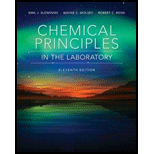
Concept explainers
You are given a colorless unknown solution that contains one of the following salts:
Want to see the full answer?
Check out a sample textbook solution
Chapter 12 Solutions
Chemical Principles in the Laboratory
- You are given four different aqueous solutions and told that they each contain NaOH, Na2CO3, NaHCO3, or a mixture of these solutes. You do some experiments and gather these data about the samples. Sample A: Phenolphthalein is colorless in the solution. Sample B: The sample was titrated with HCl until the pink color of phenolphthalein disappeared, then methyl orange was added. The solution became pink. Methyl orange changes color from pH 3.01 (red) to pH 4.4 (orange). Sample C: Equal volumes of the sample were titrated with standardized acid. Using phenolphthalein as an indicator required 15.26 mL of standardized acid to change the phenolphthalein color. The other sample required 17.90 mL for a color change using methyl orange as the indicator. Sample D: Two equal volumes of the sample were titrated with standardized HCl. Using phenolphthalein as the indicator, it took 15.00 mL of acid to reach the equivalence point; using methyl orange as the indicator required 30.00 mL HCl to achieve neutralization. Identify the solute in each of the solutions.arrow_forward1. What is the balanced net ionic equation for the equilibrium involving the solutbility of Mg (OH)2? 2. When heating the mixture it had no color and the reaction was declared endothermic. Is the forward reaction endothermic or exothermic and why? What is the balanced net ionic equation when heat is included? 3. Most solids are more soluable in warm water than cold water. Does the soluability of Mg (OH)2 fit this pattern? Why?arrow_forwardWhat do you understand about the manufacture of chemical solutions? How to (a) make 1000 mL of 0.2 N hydrochloric acid solution from 1 N standard solution and (b) make 100 mL of 0.5 N sodium hydroxide secondary standard solution (known BM = 40 g / mL)? Explain!arrow_forward
- In Analytical Chemistry, we are conducting an Absorbance Lab using CuSO4 . 5H2O . In the lab we are conducting a calibration curve and as part of our prelaboratory procedure we are asked to calculate the molarity of dilutions made from a stock solution; however, I am unsure how the crystalline water affects this calculation or if it is simply a straight forward C1V1=C2V2 calculation. I would really appreciate the help! "Calculate the concentration for each solution that are prepared by the following: Molarity (M) 2.00 mL of stock diluted to 10.00 mL 4.00 mL of stock diluted to 10.00 mL 6.00 mL of stock diluted to 10.00 mL 8.00 mL of stock diluted to 10.00 mL The stock solution is .1000M CuSO4 5H2O.arrow_forwardQ1)Consider these compounds: A. MgCO3 B. Ni(OH)2 C. AgI D. MgF2 Complete the following statements by entering the letter(s) corresponding to the correct compound(s). (If more than one compound fits the description, include all the relevant compounds by writing your answer as a string of characters without punctuation, e.g, ABC.) Without doing any calculations it is possible to determine that iron(II) carbonate is more soluble than______ , and iron(II) carbonate is less soluble than______ . It is not possible to determine whether iron(II) carbonate is more or less soluble than______ by simply comparing Ksp values.arrow_forwardWrite the balanced NET ionic equation for the reaction when (NH₄)₂CO₃ and CaCl₂ are mixed in aqueous solution. If no reaction occurs, simply write only NR. Be sure to include the proper phases for all species within the reaction.arrow_forward
- Is Mn(OH)2 soluable in water?arrow_forwardExplain why a dialysis solution must have a low sodiumion concentration if it is designed to remove excesssodium ions from the blood.arrow_forwardGive only typing answer with explanation and conclusion complete and name the chemical reaction types of the following reactions in aqueous solution Hg2(NO3)2(aq)+CuSO4arrow_forward
- 1. Intel uses a solution of potassium hydroxide to etch silicon wafers for manufacturing processors.They purchase a solution of 33% (m/m) KOH that has a density of 1.21 g/mL. This is called Developer Solution.However, for certain applications, developer solution is too concentrated. For these special applications, 25 L of Developer Solution is diluted up to a final volume of 100. L. This is called Diluted Developer Solution. Part 1: Calculate the molar concentration of the KOH Developer Solution? Part 2: Calculate the molar concentration of the Diluted KOH Developer Solution? Part 3: An out of control robot spills an unknown amount of the regular KOH Developer solution. Does the remaining solution still have the same concentration? Why or why not?arrow_forwardDissolve a spatula-tip of lead(II) nitrate in 5 mL tap water in a test tube. In another test tube, dissolve a spatula-tip of potassium iodide in tap water (5 mL). Then mıx the two solutions together Shake the mixture and then wait for about 3 minutes. Record your observations: Write a chemical equation for the chemical reaction that occurred.arrow_forwardIf you are writing an equation of a weak electrolyte dissolving in H20 would it still create cations and anions? An example would be the disolution of NH4OH(aq) in H20(l)?arrow_forward
 Chemistry & Chemical ReactivityChemistryISBN:9781337399074Author:John C. Kotz, Paul M. Treichel, John Townsend, David TreichelPublisher:Cengage Learning
Chemistry & Chemical ReactivityChemistryISBN:9781337399074Author:John C. Kotz, Paul M. Treichel, John Townsend, David TreichelPublisher:Cengage Learning Chemistry & Chemical ReactivityChemistryISBN:9781133949640Author:John C. Kotz, Paul M. Treichel, John Townsend, David TreichelPublisher:Cengage Learning
Chemistry & Chemical ReactivityChemistryISBN:9781133949640Author:John C. Kotz, Paul M. Treichel, John Townsend, David TreichelPublisher:Cengage Learning Chemistry: The Molecular ScienceChemistryISBN:9781285199047Author:John W. Moore, Conrad L. StanitskiPublisher:Cengage Learning
Chemistry: The Molecular ScienceChemistryISBN:9781285199047Author:John W. Moore, Conrad L. StanitskiPublisher:Cengage Learning


